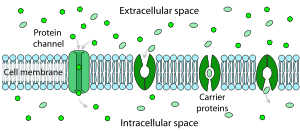
Facilitated diffusion
Encyclopedia

- Not to be confused with diffusionDiffusionMolecular diffusion, often called simply diffusion, is the thermal motion of all particles at temperatures above absolute zero. The rate of this movement is a function of temperature, viscosity of the fluid and the size of the particles...
. Facilitated diffusion is not a type of diffusion (thermal motion) but a type of transport process.
..
Facilitated diffusion (also known as facilitated transport or passive-mediated transport) is a process of passive transport
Passive transport
Passive transport means moving biochemicals and other atomic or molecular substances across membranes. Unlike active transport, this process does not involve chemical energy, because, unlike in an active transport, the transport across membrane is always coupled with the growth of entropy of the...
, facilitated by integral proteins. Facilitated diffusion is the spontaneous passage of molecules or ions across a biological membrane passing through specific transmembrane integral proteins. The facilitated diffusion may occur either across biological membrane
Biological membrane
A biological membrane or biomembrane is an enclosing or separatingmembrane that acts as a selective barrier, within or around a cell. It consists of a lipid bilayer with embedded proteins that may constitute close to 50% of membrane content...
s or through aqueous compartments of an organism.
Polar molecules and charged ions are dissolved in water but they can not diffuse freely across the plasma membrane due to the hydrophobic
Hydrophobe
In chemistry, hydrophobicity is the physical property of a molecule that is repelled from a mass of water....
nature of the fatty acid tails of phospholipid
Phospholipid
Phospholipids are a class of lipids that are a major component of all cell membranes as they can form lipid bilayers. Most phospholipids contain a diglyceride, a phosphate group, and a simple organic molecule such as choline; one exception to this rule is sphingomyelin, which is derived from...
s that make up the lipid bilayer
Lipid bilayer
The lipid bilayer is a thin membrane made of two layers of lipid molecules. These membranes are flat sheets that form a continuous barrier around cells. The cell membrane of almost all living organisms and many viruses are made of a lipid bilayer, as are the membranes surrounding the cell nucleus...
s. Only small nonpolar molecules, such as oxygen
Oxygen
Oxygen is the element with atomic number 8 and represented by the symbol O. Its name derives from the Greek roots ὀξύς and -γενής , because at the time of naming, it was mistakenly thought that all acids required oxygen in their composition...
can diffuse easily across the membrane. All polar molecules are transported across membranes
Cell membrane
The cell membrane or plasma membrane is a biological membrane that separates the interior of all cells from the outside environment. The cell membrane is selectively permeable to ions and organic molecules and controls the movement of substances in and out of cells. It basically protects the cell...
by proteins that form transmembrane channels. These channels are gated so they can open and close, thus regulating the flow of ions or small polar molecules. Larger molecules are transported by transmembrane carrier proteins, such as permease
Permease
The permeases are membrane transport proteins, a class of multipass transmembrane proteins that facilitate the diffusion of a specific molecule in or out of the cell by passive transport...
s that change their conformation as the molecules are carried through, for example glucose
Glucose
Glucose is a simple sugar and an important carbohydrate in biology. Cells use it as the primary source of energy and a metabolic intermediate...
or amino acids.
Non-polar molecules, such as retinol
Retinol
Retinol is one of the animal forms of vitamin A. It is a diterpenoid and an alcohol. It is convertible to other forms of vitamin A, and the retinyl ester derivative of the alcohol serves as the storage form of the vitamin in animals....
or fatty acid
Fatty acid
In chemistry, especially biochemistry, a fatty acid is a carboxylic acid with a long unbranched aliphatic tail , which is either saturated or unsaturated. Most naturally occurring fatty acids have a chain of an even number of carbon atoms, from 4 to 28. Fatty acids are usually derived from...
s are poorly soluble in water. They are transported through aqueous compartments of cells or through extracellular space by water-soluble carriers as retinol binding protein
Retinol binding protein
Retinol-binding proteins are a family of proteins with diverse functions. They are carrier proteins that bind retinol.Assessment of retinol-binding protein is used to determine visceral protein mass in nutritional studies related to health.-Genes:...
. The metabolites are not changed because no energy is required for facilitated diffusion. Only permease changes its shape in order to transport the metabolites. The form of transport through cell membrane which modifies its metabolites is the group translocation
PEP group translocation
PEP group translocation, also known as the phosphotransferase system or PTS, is a distinct method used by bacteria for sugar uptake where the source of energy is from phosphoenolpyruvate . It is known as multicomponent system that always involves enzymes of the plasma membrane and those in the...
transportation.

